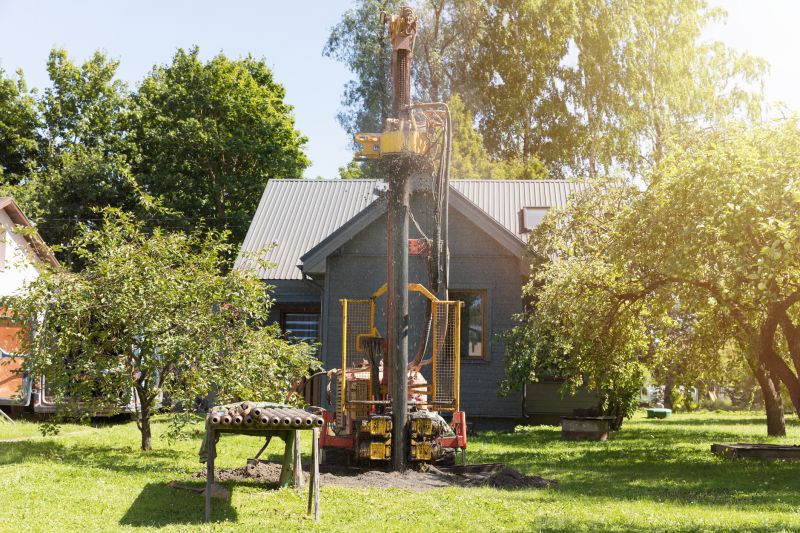Top Products for Water Well Drilling You Can Rely On
Identify essential equipment and tools that ensure safety, efficiency, and success in your water well drilling endeavors.
 Water well drilling involves a complex process that requires specialized equipment to access underground water sources efficiently and safely. The selection of appropriate products is essential for ensuring a successful drilling operation, whether for residential, agricultural, or commercial purposes. Drilling equipment must be durable, reliable, and capable of handling various soil and rock conditions. From handheld tools to heavy-duty machinery, the range of products available caters to different scales and complexities of water well projects.
Water well drilling involves a complex process that requires specialized equipment to access underground water sources efficiently and safely. The selection of appropriate products is essential for ensuring a successful drilling operation, whether for residential, agricultural, or commercial purposes. Drilling equipment must be durable, reliable, and capable of handling various soil and rock conditions. From handheld tools to heavy-duty machinery, the range of products available caters to different scales and complexities of water well projects.
Top Overall Option
Heavy-Duty Water Well Drilling Rig
A versatile and robust drilling rig designed to handle a variety of soil and rock conditions, suitable for both professional and serious DIY projects. Its adjustable features and durable construction enable efficient drilling to moderate depths, making it a reliable choice for many water well applications.
Types of Products For Water Well Drillings
Handheld Core Drill Bits
Portable core drill bits ideal for shallow drilling and sampling in various soil types.
Percussion Drilling Equipment
Tools designed for breaking through tough soil and rock layers during deeper drilling operations.
Casing Pipes and Liners
Essential for maintaining the integrity of the borehole and preventing collapse during drilling.
Portable Drill Rigs
Mobility-focused rigs suitable for small-scale or remote drilling projects.
Industrial-Grade Drill Rigs
Heavy-duty machinery designed for large-scale, deep water well drilling operations.
Submersible Pumps
Pumps used to extract water from the well once drilling is complete.
Air Compressors
Equipment necessary for powering certain types of drilling tools, especially in percussion drilling.
Mud Pumps
Used to circulate drilling mud, which helps cool the drill bit and remove debris.
Drill Bit Sets
Variety of drill bits designed for different soil and rock conditions to optimize drilling efficiency.
Water Level Meters
Tools for measuring the depth of water in the borehole during and after drilling.
Borehole Logging Equipment
Devices used to assess the geological formations encountered during drilling.
Drilling Fluids and Additives
Materials used to lubricate, cool, and stabilize the borehole during drilling.
Popular Choices
Compact rigs that offer mobility and ease of setup for small to medium projects.
Reliable pumps suitable for extracting water from significant depths in various settings.
Effective for shallow, quick drilling in soft soils or for sampling purposes.
Powerful equipment that uses hydraulic systems for efficient deep drilling.
Tools for quick and accurate water level measurement during drilling.
Components that protect the well and facilitate water flow into the borehole.
Equipment for preparing and mixing drilling fluids on-site.
Lightweight compressors suitable for powering percussion tools in remote locations.
Tools for extracting core samples during drilling to analyze subsurface conditions.
Equipment for analyzing water quality once the well is drilled and water is accessible.
Instruments used to record geological formations and water yield potential.
Understanding the different components involved in water well drilling can help in making informed purchasing decisions. Core drill bits, casing pipes, drill rigs, and pumps are among the critical elements that contribute to the overall success of a drilling operation. Properly selected equipment can facilitate smoother drilling, reduce downtime, and improve the quality of the well. Maintenance and compatibility with existing tools are also important factors to consider to ensure longevity and efficiency.
The process of selecting products for water well drilling should be guided by the specific needs of the project, including depth requirements, soil type, and water yield expectations. While some projects may only require basic hand tools and small portable rigs, others might necessitate large-scale, industrial-grade machinery. Safety features, ease of use, and availability of replacement parts are additional considerations that can influence the overall effectiveness of the equipment chosen. Investing in quality products can help achieve better results and reduce operational challenges over time.
Whether you are a professional driller or a DIY enthusiast, understanding the range of available products and their applications can significantly enhance your project outcomes. Proper planning and equipment selection are vital steps in ensuring the success of your water well drilling endeavors. By focusing on reliable, well-suited tools and components, you can streamline the process and improve the likelihood of securing a clean, sustainable water source.
Key Buying Considerations
- Determine the depth and diameter of the well to select appropriately rated equipment.
- Assess soil and rock conditions to choose suitable drill bits and drilling methods.
- Consider the mobility and size of the equipment based on site accessibility and project scale.
- Evaluate the power source requirements, such as electric, hydraulic, or gasoline-powered tools.
- Check compatibility of parts and accessories for future maintenance and upgrades.
- Prioritize safety features and ergonomic design to ensure operator safety and comfort.
- Review the availability of replacement parts and technical support from suppliers.
- Estimate the water yield needs to match the capacity of pumps and casing sizes.
- Consider the environmental conditions, such as moisture and temperature, that could affect equipment durability.
- Factor in budget constraints while balancing quality and functionality.
- Look for equipment with clear instructions and user support resources.
- Assess the ease of transportation and setup, especially for remote or small-scale projects.
- Understand local regulations and permits related to water well drilling.
- Review user feedback and expert recommendations to gauge equipment reliability.
- Plan for maintenance and operational costs over the lifespan of the equipment.
